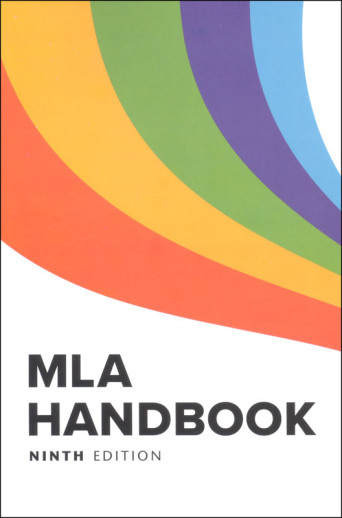We use cookies to make your experience better. To comply with the new e-Privacy directive, we need to ask for your consent to set the cookies. Learn more.
MLA Handbook Ninth Edition
If you've written a research paper for any outside accountability source (i.e. anyone other than your mother), then you've probably run across the term MLA style or form. "MLA style represents a consensus among teachers, scholars, and librarians in the fields of language and literature on the conventions for documenting research, and those conventions will help you organize your research paper coherently" (foreword). In other words, if you're going to be writing research papers at any point now or in the future (i.e. college), MLA style is at least an acceptable form if not the required form for doing so. This official publication of the Modern Language Association will both teach you MLA style and provide help for you at all stages of your research/writing project. Covering all issues of citing/documenting references as well as plagiarism, mechanics and general format, and providing countless examples, this is the book that will take a student from high school writing through college (and beyond). The 8th edition provides access to a free, online companion website that includes samples, writing tips, downloadable templates and more. 146 pgs. pb ~ Janice
The Modern Language Association, the authority on research and writing, takes a fresh look at documenting sources in the eighth edition of the MLA Handbook. Works are published today in a dizzying range of formats. A book, for example, may be read in print, online, or as an e-book—or perhaps listened to in an audio version. On the Web, modes of publication are regularly invented, combined, and modified. Previous editions of the MLA Handbook provided separate instructions for each format, and new formats required additional instructions. In this groundbreaking edition of its best-selling handbook, the MLA recommends instead one universal set of guidelines, which writers can apply to any type of source.
Shorter and redesigned for easy use, the eighth edition of the MLA Handbook guides writers through the principles behind evaluating sources for their research. It then shows them how to cite sources in their writing and create useful entries for the works-cited list.
These materials cover various types of informational writing, includingpersuasive writing, essays, outlines, and research papers.
| Product Format: | Paperback |
|---|---|
| Brand: | Modern Language Association |
| Grades: | 9-AD |
| ISBN: | 9781603293518 |
| Length in Inches: | 9 |
| Width in Inches: | 6 |
| Height in Inches: | 1.5 |
| Weight in Pounds: | 1.2063 |

